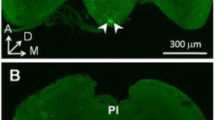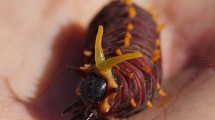Abstract
Eleven polyhydroxy alkaloids of plant origin were tested for anti-feedant effects against larvae of the lepidopteransSpodoptera littoralis, Spodoptera frugiperda, Heliothis virescens, andHelicoverpa armigera. Data from behavioral and electrophysiological investigations were correlated to reveal information on the mode of action of the antifeedants. The pyrrolidine DMDP was an effective antifeedant for all four species, whereas the piperidines fagomine and XZ-1 and the pyrrolizidine alexine were all ineffective as antifeedants. The activity of the pyrrolidines CYB-3 and DAB-1, the piperidines DNJ, DMJ, and BR1, and the bicyclic octahydroindolizine castanospermine varied among species. The investigation focuses on the structural similarities between some of the alkaloids and some common phagostimulatory sugars and illustrates a neural interaction involving the neurons that are differentially responsive to alkaloids and sugars. InS. littoralis, the neurons responding specifically to the alkaloids DMDP, DAB-1, and castanospermine and to the sugars fructose, sucrose, and glucose are more active when the compounds are applied singly than when an alkaloid and a sugar are applied together. The implications for the occurrence and functioning of different sugar receptor sites are discussed.
Similar content being viewed by others
References
Amakawa, T., Kijima, H., andMorita, H. 1975. Insoluble alpha-glucosidase: Possible pyranose site of the sugar receptor of the labella of the blowfly,Phormia regina.J. Insect Physiol. 21:1419–1425.
Bernays, E.A., andLee, J.C. 1988. Food aversion learning in the polyphagous grasshopperSchistocerca americana.Physiol. Entomol. 13:131–137.
Blaney, W.M., andSimmonds, M.S.J. 1987. Experience: A modifier of neural and behavioral sensitivity, pp. 237–241,in V. Labeyrie, G. Fabres, and D. Lachaise (eds.). Insects-Plants. Junk, Dordrecht.
Blaney, W.M., Simmonds, M.S.J., Evans, S.V., andFellows, L.E. 1984. The role of the plant secondary compound 2,5-dihydroxymethyl-3,4-dihydroxypyrrolidine as a feeding inhibitor for insects.Entomol. Exp. Appl. 36:209–216.
Blaney, W.M., Simmonds, M.S.J., Ley, S.V., andKatz, R.B. 1987. An electrophysiological and behavioural study of insect antifeedant properties of natural and synthetic drimane-related compounds.Physiol. Entomol. 12:281–291.
Blaney, W.M., Simmonds, M.S.J., Ley, S.V., andJones, P.S. 1988. Insect antifeedants: A behavioural and electrophysiological investigation of natural and synthetically derived clerodane diterpenoids.Entomol. Exp. Appl. 46:267–274.
Blom, F. 1978. Sensory activity and food intake: A study of input-output relationships in two phytophagous insects.Neth. J. Zool. 28:277–340.
Campbell, B.C., Molyneux, R.J., andJones, K.C. 1987. Differential inhibition by castanospermine of various insect disaccharidases.J. Chem. Ecol. 13:1759–1770.
de Boer, G.V., Dethier, V.G., andSchoonhoven, L.M. 1977. Chemoreceptors in the preoral cavity of the tobacco hornworm,Manduca sexta and their possible function in feeding behaviour.Entomol. Exp. Appl. 21:287–298.
Dethier, V.G. 1980. Food-aversion learning in two polyphagous caterpillars,Diacrisia virginica andEstigmene congrua.Physiol. Entomol. 5:321–325.
Dimetry, N.Z. 1976. Growth and development of the American bollworm,Heliothis armigera Hubner under laboratory mass-rearing conditions.Experientia 32:1006–1007.
Dreyer, D.L., Jones, K.C., andMolyneux, R.J. 1985. Feeding deterrency of some pyrrolizidine, indolizidine and quinolizidine alkaloids towards pea aphid (Acyrthosiphon pisum) and evidence for phloem transport of the indolizidine alkaloid swainsonine.J. Chem. Ecol. 11:1045–1051.
Evans, S.V., Gatehouse, A.M.R., andFellows, L.E. 1985. Detrimental effects of 2,5-dihy-droxymethyl-3,4-dihydroxypyrrolidine in some tropical legumes on larvae of the bruchidCallosobruchus maculatus.Entomol. Exp. Appl. 37:257–261.
Fellows, L.E., Kite, G.C., Nash, R.J., Simmonds, M.S.J., andScofield, A.M. 1989. Castanospermine, swainsonine and related polyhydroxy alkaloids: Structure, distribution and biological activity, pp. 395–427,in J.E. Poulton, J.T. Romeo, and E.E. Conn (eds.). Plant Nitrogen Metabolism. Plenum Publishing, New York.
Frazier, J., andHanson, F.E. 1986. Electrophysiological recording and analysis of insect chemosensory responses, pp. 285–330,in J.R. Miller and T.A. Miller (eds.). Insect-Plant Inter-actions. Springer-Verlag, New York.
Hanamori, T., Shiraishi, A., Kijima, H., andMorita, H. 1974. Structure of effective monosaccharides in stimulation of the sugar receptor of the fly.Chem. Senses Flavor 1:147–166.
Hansen, K. 1974. Alpha-glucosidases as sugar receptor proteins in flies, pp. 207–232,in L. Jaenicke (ed.). 25 Mosbacher Colloquium Ges. Biol. Chem. Springer-Verlag, Heidelberg.
Hansen, K., andWieczorek, H. 1981. Biochemical aspects of sugar reception in insects, pp. 139–162,in R.H. Cagan and M.R. Kare (eds.). Biochemistry of Taste and Olfaction. Academic Press, New York.
Hanson, F.E., andde Boer, G. 1987. What sensory organs control selection by leaf-chewing caterpillars? p. 391,in V. Labeyrie, G. Fabres, and D. Lachaise (eds.). Insects-Plants. Junk, Dordrecht.
Hanson, F.E., andDethier, V.G. 1973. Role of gustation and olfaction in food plant discrimination in the tobacco hornworm,Manduca sexta.J. Insect Physiol. 19:1019–1034.
Hodgson, E.S., Lettvin, J.Y., andRoeder, K.D. 1955. Physiology of a primary chemoreceptor unit.Science 122:417–418.
Ishikawa, S., Hirao, T., andArai, M. 1969. Chemosensory basis of host plant selection in the silkworm.Entomol. Exp. Appl. 12:544–545.
Jermy, T. 1990. Prospects of the antifeedant approach to pest control—a critical review.J. Chem. Ecol. 16:3151–3166.
Kijima, H., Koizumi, O., andMorita, H. 1973. Alpha-glucosidase at the tip of the contact chemosensory seta of the blowfly,Phormia regina.J. Insect Physiol. 19:1351–1362.
Kijima, J., Amakawa, T., Nakashima, M., andMorita, H. 1977. Properties of membrane-bound alpha-glucosidases: Possible sugar receptor protein of the blowfly,Phormia regina.J. Insect Physiol. 23:469–479.
Ma, W.C. 1972. Dynamics of feeding inPieris brassicae Linn, as a function of chemosensory input: A behavioural, ultrastructural and electrophysiological study.Meded. Landbouwhogesch. Wageningen 72(11): 1–62.
Nakashima, M., Enomoto, K., Kijima, H., andMorita, H. 1982. Discrepancy between the affinities of certain inhibitors for the membrane-bound alpha-glucosidases and those for the sugar receptor of flies.Insect Biochem. 12:579–585.
Nash, R.J., Fenton, K.A., Gatehouse, A.M.R., andBell, E.A. 1986. Effects of the plant alkaloid castanospermine as an antimetabolite of storage pests.Entomol. Exp. Appl. 42:71–77.
Ozaki, M. 1988. A possible sugar receptor protein found in the labellum of the blowfly,Phormia regina.Zool. Sci. 5:281–290.
Schoonhoven, L.M. 1987. What makes a caterpillar eat? The sensory code underlying feeding behavior, pp. 69–97,in R.F. Chapman, E.A. Bernays, and J.G. Stoffolano, Jr. (eds.). Perspectives in Chemoreception and Behaviour. Springer-Verlag, New York.
Shimada, I. 1978. The stimulating effect of fatty acids and amino acid stimulation in the labellar sugar receptor of the fleshfly.J. Gen. Physiol. 71:19–36.
Shimada, I., Shiraishi, A., Kijima, H., andMorita, H. 1974. Separation of two receptor sites in a single labellar sugar receptor of the fleshfly by treatment with p-chloromercuribenzoate.J. Insect Physiol. 20:605–621.
Simmonds, M.S.J., andBlaney, W.M. 1984. Some neurophysiological effects of azadirachtin on lepidopterous larvae and their feeding response, pp. 163–180,in H. Schmutterer and K.R.S. Ascher (eds.). Proceedings 2nd International Neem Conference, Rauischholzhausen, Eschborn.
Simmonds, M.S.J., andBlaney, W.M. 1990. Gustatory coding in lepidopterans. Proceedings 7th International Symposium, Insect-Plant Relationships, Budapest 1989. (In press).
Simmonds, M.S.J., Fellows, L.E., andBlaney, W.M. 1989. Wild plants a source of novel anti-insect compounds: Alkaloidal glycosidase inhibitors, pp. 365–377,in G. Wickens, N. Haq, and P. Day (eds.). New Crops for Food and Industry. Croom Helm, England.
Simpson, S.J., Simmonds, M.S.J., Blaney, W.M., andJones, G. 1990. Compensatory dietary selection behaviour in larvalLocusta migratoria andSpodoptera littoralis: The effect of a single deficient meal duringad libitum feeding.Physiol. Entomol. 15:235–242.
Wieczorek, H., andKoppl, R. 1982. Reaction spectra of sugar receptors in different taste hairs of the fly.J. Comp. Physiol. 149:207–213.
Wieczorek, H., andWolfe, G. 1989. The labellar sugar receptor ofDrosophila.J. Comp. Physiol. 164:825–834.
Wieczorek, H., Shimada, I., andHopperdietzel, C. 1988. Treatment with pronase uncouples water and sugar reception in the labellar water receptor of the blowfly.J. Comp. Physiol. A 163:413–419.
Author information
Authors and Affiliations
Rights and permissions
About this article
Cite this article
Simmonds, M.S.J., Blaney, W.M. & Fellows, L.E. Behavioral and electrophysiological study of antifeedant mechanisms associated with polyhydroxy alkaloids. J Chem Ecol 16, 3167–3196 (1990). https://doi.org/10.1007/BF00979618
Received:
Accepted:
Issue Date:
DOI: https://doi.org/10.1007/BF00979618




